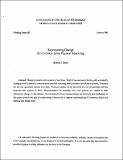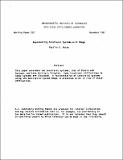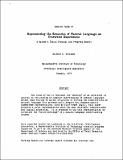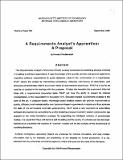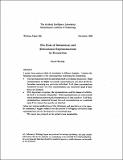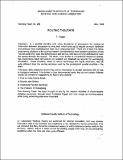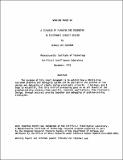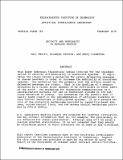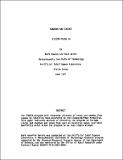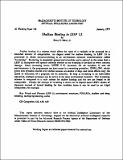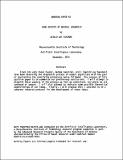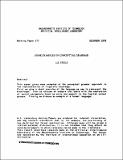Browsing AI Working Papers (1971 - 1995) by Title
Now showing items 206-225 of 291
-
Report on the Second Workshop on Distributed AI
(MIT Artificial Intelligence Laboratory, 1982-01)On June 24, 1981 twenty-five participants from organizations around the country gathered in MIT's Endicott House for the Second Annual Workshop on Distributed AI. The three-day workshop was designed as an informal meeting, ... -
Report on the Workshop on Distributed AI
(MIT Artificial Intelligence Laboratory, 1980-09)On June 9-11, 22 people gathered at Endicott House for the first workshop on the newly emerging topic of Distributed AI. They came with a wide range of views on the topic, and indeed a wide range of views of what precisely ... -
Reporter: An Intelligent Noticer
(MIT Artificial Intelligence Laboratory, 1977-11-15)Some researchers, notably Schank and Abelson, (1975) have argued for the existence of large numbers of scripts as a representation for complex events. This paper adopts a different viewpoint. I consider complex events to ... -
Representing Change for Common-Sense Physical Reasoning
(MIT Artificial Intelligence Laboratory, 1983-01)Change pervades every moment of our lives. Much of our success in dealing with a constantly changing world is based in common-sense physical reasoning about processes and physical systems. Processes are the way quantities ... -
Representing Constraint Systems with Omega
(1981-11)This paper considers two constraint systems, that of Steele and Sussman, and Alan Borning's Thinglab. Some functional difficulties in these systems are discussed. A representation of constraint systems using the description ... -
Representing the Semantics of Natural Language as Constraint Expressions
(MIT Artificial Intelligence Laboratory, 1975-01)The issue of how to represent the "meaning" of an utterance is central to the problem of computer understanding of natural language. Rather than relying on ad-hoc structures or forcing the complexities of natural language ... -
A Requirements Analyst's Apprentice: A Proposal
(MIT Artificial Intelligence Laboratory, 1986-09)The Requirements Analyst's APprentice (RAAP) partially automates the modeling process involved in creating a software requirement. It uses knowledge of the specific domain and general experience regarding software requirements ... -
Resolving Visual Ambiguity with a Probe
(MIT Artificial Intelligence Laboratory, 1971-07)The eye-hand robot at the Artificial Intelligence Laboratory now possesses the ability to occasionally copy simple configurations of blocks, using spare parts about whose presence it knows. One problem with which it cannot ... -
Review of Human Vision Facts
(MIT Artificial Intelligence Laboratory, 1973-03-20)This note is a collection of well known interesting facts about human vision. All parameters are approximate. Some may be wrong. There are sections on retina physiology, eye optics, light adaptation, psychological curios, ... -
The Role of Intensional and Extensional Representations in Simulation
(MIT Artificial Intelligence Laboratory, 1984-12)I review three systems which do simulation in different domains. I observe the following commonality in the representations underlying the simulations: • The representations used for individuals tend to be domain-dependent. ... -
Routing Thoughts
(MIT Artificial Intelligence Laboratory, 1984-05)In a parallel machine with many thousands of processors the routing of information between processors is a key task, which turns out to require as much hardware and perhaps more sophistication than local computing itself. ... -
A scenario of Planning and Debugging in Electronic Circuit Design
(MIT Artificial Intelligence Laboratory, 1973-12)The purpose of this short document is to exhibit how a HACKER-like top-down planning and debugging system can be applied to the problem of the design and debugging of simple analog electronic circuits. I believe, and I ... -
Security and Modularity in Message Passing
(MIT Artificial Intelligence Laboratory, 1979-02)This paper addresses theoretical issues involved for the implementation of security and modularity in concurrent systems. It explicates the theory behind a mechanism for safely delegating messages to shared handlers in ... -
The Semantic Component of PAL: The Personal Assistant Language Understanding Program
(MIT Artificial Intelligence Laboratory, 1977-03)This paper summarizes the design and implementation of the "semantics" module of a natural language undertanding system for the personal assistant domain. This module includes mappings to deep frames, noun phrase referencing ... -
Shadows and Cracks
(MIT Artificial Intelligence Laboratory, 1971-06)The VIRGIN program will interpret pictures of crack and shadow free scenes by labelling them according to the Clowes/Huffman formalism. This paper indicates methods of extending the program to include cracks and shadows ... -
Shallow Binding in LISP 1.5
(MIT Artificial Intelligence Laboratory, 1977-01)Shallow binding is a scheme which allows the value of a variable to be accessed in a bounded amount of computation. An elegant model for shallow binding in LISP 1.5 is presented in which context-switching is an environment ... -
Shedding Light on Shadows
(MIT Artificial Intelligence Laboratory, 1972-06)This paper describes methods which allow a program to analyze and interpret a variety of scenes made up of polyhedra with trihedral vertices. Scenes may contain shadows, accidental edge alignments, and some missing lines. ... -
Simulating a Semantic Network in LMS
(MIT Artificial Intelligence Laboratory, 1980-09-29)A semantic network is a collection of nodes and the links between them. The nodes represent concepts, functions and entities, and the links represent relationships between varoius nodes. Any semantic network must be supplied ... -
Some Aspects of Medical Diagnosis
(MIT Artificial Intelligence Laboratory, 1973-12)Since mid July Steve Pauker, Jerome Kassirer, and I (Gerald Jay Sussman) have been observing the diagnostic process of expert physicians with the goal of abstracting the underlying procedures being followed. One purpose ... -
Some Examples of Conceptual Grammar
(MIT Artificial Intelligence Laboratory, 1978-12)This paper gives some examples of the conceptual grammar approach to the representation of linguistic knowledge. First we give a short overview of the language we use to represent knowledge. Then we discuss an example ...




